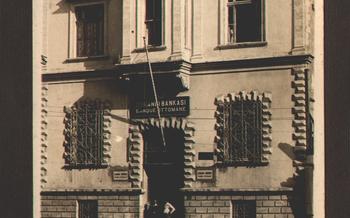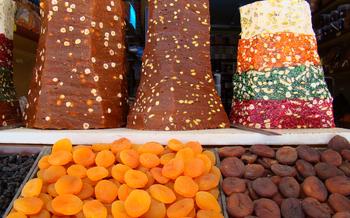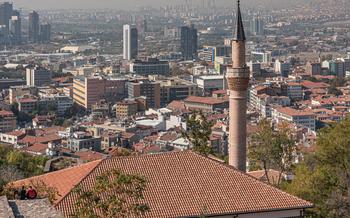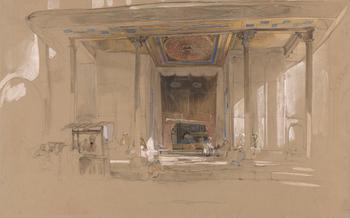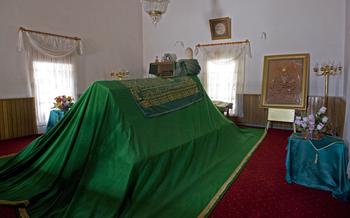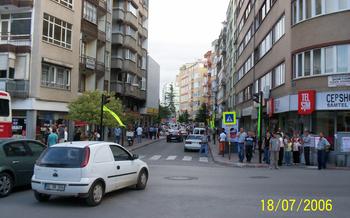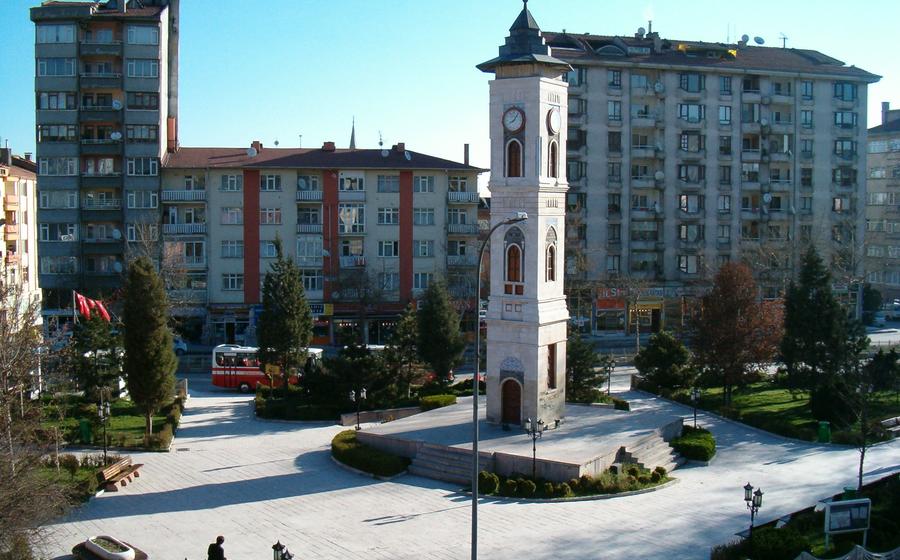
Senamik Great Mosque
- Historical Significance
- Architectural Features
- Interior Design and Decorations
- Religious Significance
- Visiting Information
- Photography Opportunities
- Nearby Attractions
- Historical Context
- Cultural Significance
- Restoration and Preservation
- Local Customs and Traditions
- Local Festivals and Events
- Accessibility
- Insider Tip:
Historical Significance
The Senamik Great Mosque stands as a testament to the rich history of Kütahya, dating back to the Beylik period in the 14th century. Its construction, commissioned by the Germiyanid ruler Yakup I, marked a significant milestone in the city's architectural and religious landscape. Over the centuries, the mosque has undergone several renovations and additions, reflecting the changing political and cultural influences that shaped Kütahya.
In the 16th century, during the reign of the Ottoman Empire, the mosque underwent extensive renovations under the supervision of the renowned architect Mimar Sinan. These renovations transformed the mosque's appearance, blending Seljuk and Ottoman architectural styles to create a unique and harmonious structure. The mosque's iconic domes, graceful minarets, and intricate stone carvings exemplify the architectural brilliance of this era.
In recent years, the Senamik Great Mosque has undergone significant restoration efforts aimed at preserving its historical integrity and architectural beauty. These efforts have involved meticulous restoration of the mosque's exterior and interior, including the delicate tilework, calligraphy, and decorative elements. As a result of these painstaking efforts, the mosque now stands as a vibrant and well-preserved symbol of Kütahya's rich cultural heritage.
Architectural Features
The Senamik Great Mosque stands as a testament to the harmonious blend of Seljuk and Ottoman architectural styles. Its striking stone carvings, graceful domes, and tall minarets are a testament to the skill and artistry of the builders who created this masterpiece.
Intricate geometric patterns adorn the mosque's exterior, reflecting the Islamic tradition of using mathematics and art to create beautiful and meaningful spaces. The domes, supported by elegant columns, soar towards the sky, symbolizing the mosque's connection to the heavens.
Inside, the mosque's interior is no less impressive. The walls are adorned with colorful tiles, each one telling a story from Islamic history or culture. The mihrab, the niche indicating the direction of Mecca, is a masterpiece of calligraphy, with verses from the Quran inscribed in intricate Arabic script.
The Senamik Great Mosque is a true architectural marvel, showcasing the rich heritage of Kütahya and the enduring legacy of Islamic architecture. Its unique blend of Seljuk and Ottoman styles makes it a must-see destination for anyone interested in history, architecture, or religion.
Interior Design and Decorations
The interior of the Senamik Great Mosque is a testament to the artistry and devotion of its builders. The walls and ceilings are adorned with exquisite calligraphy, colorful tiles, and intricate patterns that tell stories of faith and devotion. The calligraphy, created by master calligraphers, features verses from the Quran and the names of Allah in elegant Arabic script. The tiles, in shades of blue, green, and turquoise, form intricate geometric patterns that create a sense of awe and wonder. The patterns, inspired by Islamic art, represent the unity and harmony of the universe.
One of the most striking features of the mosque's interior is the mihrab, a niche in the wall that indicates the direction of Mecca. The mihrab is intricately carved with floral motifs and verses from the Quran, highlighting its significance as a focal point for prayer. The pulpit, from which the imam delivers sermons, is also adorned with intricate carvings, showcasing the craftsmanship of the mosque's builders.
Every element of the mosque's interior design holds cultural and religious significance. The intricate patterns and calligraphy serve as visual reminders of the beauty and complexity of the Islamic faith. The use of natural light, filtering through the stained glass windows, creates a serene and contemplative atmosphere, conducive to prayer and reflection.
Religious Significance
The Senamik Great Mosque serves as a spiritual beacon for the Muslim community in Kütahya, fostering a profound sense of religious devotion and connection. Daily prayers resonate within its sacred walls, uniting worshippers in a shared journey of faith. During the holy month of Ramadan, the mosque transforms into a vibrant center of spirituality, hosting special prayers, communal iftars, and Taraweeh recitations that fill the air with an atmosphere of reverence and camaraderie. It is a place where religious traditions are meticulously observed, and the teachings of Islam are imparted to future generations, nurturing a deep spiritual bond among the faithful. Whether seeking solace through prayer or witnessing the vibrant tapestry of Islamic rituals, visitors to the Senamik Great Mosque are sure to be touched by its profound religious significance.
Visiting Information
To fully immerse yourself in the spiritual and cultural significance of the Senamik Great Mosque, it is essential to plan your visit carefully. The mosque is open to the public daily during daylight hours, allowing ample opportunity for exploration and reflection. Admission is free, welcoming all visitors to experience its architectural wonders without any financial barriers. While there is no strict dress code, it is customary to dress modestly and respectfully when visiting a place of worship.
To avoid the crowds and capture the mosque's beauty in its purest form, consider visiting early in the morning or late in the afternoon. These times offer the most favorable lighting conditions, casting long shadows that enhance the intricate details of the mosque's facade.
Before entering the mosque, remove your shoes and place them neatly in the designated racks. This is a customary practice in Islamic tradition to maintain the sanctity and cleanliness of the prayer space.
As you explore the mosque, take your time to admire the stunning calligraphy, intricate carvings, and colorful tiles that adorn its walls and ceilings. Observe the faithful performing their daily prayers, creating a serene and spiritual atmosphere. Remember to be respectful and maintain silence while inside the mosque, allowing others to focus on their prayers.
After your visit to the mosque, consider exploring the surrounding area, which is home to several other historical and cultural attractions. This will provide a comprehensive experience of Kütahya's rich heritage and traditions.
Photography Opportunities
The Senamik Great Mosque presents a feast for the eyes, offering countless opportunities for capturing stunning photographs. Its intricate architecture, graceful domes, and towering minarets create a picturesque backdrop that will leave you in awe. As you explore the mosque, take the time to admire the intricate stone carvings that adorn its exterior. These carvings showcase the exceptional craftsmanship of the artisans who built this magnificent structure.
For the best photographic results, position yourself at an angle that allows you to capture the full grandeur of the mosque. Experiment with different perspectives to create dynamic compositions. The mosque looks particularly stunning when bathed in the warm glow of the golden hour, just before sunset. This is an ideal time to capture the play of light and shadow on the mosque's facade.
While photography is permitted within the mosque, it is essential to be respectful of the sanctity of the place. Avoid using flash or tripods, and be mindful of worshippers who may be present. By following these guidelines, you can capture beautiful memories of your visit to the Senamik Great Mosque while maintaining a respectful demeanor.
Nearby Attractions
Complementing your visit to the Senamik Great Mosque, Kütahya offers a myriad of nearby attractions to enhance your cultural immersion. A short walk away, discover the enchanting Kütahya Museum, showcasing an array of artifacts that narrate the city's rich history and artistic heritage. Delve into the world of ceramics at the Kütahya Tiles and Ceramics Museum, renowned for its exquisite collection of handcrafted tiles and pottery. For a glimpse into the city's architectural wonders, explore the stately Government House, a testament to Ottoman grandeur, and the picturesque Ulu Mosque, with its serene courtyard and intricate tilework. As you wander through the charming streets, stumble upon hidden gems like the historic Turkish Baths, inviting you to experience the soothing traditions of a bygone era. Plan your itinerary to include these captivating attractions, creating a comprehensive cultural journey through the heart of Kütahya.
Historical Context
The Senamik Great Mosque stands as a testament to the rich history of Kütahya, a city that has witnessed the rise and fall of civilizations. During the Beylik period, Kütahya was a thriving center of trade and culture, and the construction of the mosque reflected the city's prosperity and architectural prowess.
The mosque was built at a time when Anatolia was divided into small principalities known as Beyliks. Kütahya was ruled by the Germiyanids, a powerful Turkish dynasty that played a significant role in the region's history. The Germiyanids were known for their patronage of the arts and architecture, and the Senamik Great Mosque is a testament to their cultural legacy.
The mosque's construction also coincided with a period of intense religious devotion in Anatolia. The Beyliks were deeply influenced by Sufism, a mystical branch of Islam that emphasized personal experience and connection with the divine. The Senamik Great Mosque became a center of Sufi worship and learning, attracting scholars and pilgrims from across the region.
Over the centuries, the mosque has witnessed numerous historical events. It has survived earthquakes, fires, and wars, each leaving its mark on the building's fabric. The mosque's resilience is a testament to its enduring significance as a symbol of faith and cultural heritage in Kütahya.
Cultural Significance
The Senamik Great Mosque stands as a testament to the rich heritage and traditions of Kütahya. Its architectural grandeur and intricate decorations embody the city's cultural identity and values. The mosque represents the culmination of centuries of craftsmanship, art, and architecture, showcasing the skill and artistry of local artisans. Its design reflects the blending of Seljuk and Ottoman influences, creating a unique architectural style that has become synonymous with Kütahya.
The mosque's cultural significance extends beyond its physical structure. It serves as a gathering place for the community, fostering a sense of unity and belonging among the people of Kütahya. Throughout history, the mosque has been a center for religious and cultural activities, hosting prayers, ceremonies, and educational gatherings. It has played a crucial role in preserving and promoting local traditions, customs, and beliefs, ensuring their continuity from generation to generation.
The Senamik Great Mosque embodies the spirit of Kütahya, showcasing its rich cultural heritage and serving as a source of pride for its people. It is a living testament to the city's enduring traditions and the vibrant cultural tapestry that makes Kütahya a unique and captivating destination.
Restoration and Preservation
The Senamik Great Mosque has undergone several restoration and preservation efforts throughout history to maintain its historical integrity. In the early 20th century, a comprehensive restoration project was initiated to address the mosque's deteriorating condition. Skilled craftsmen and artisans meticulously repaired the intricate stone carvings, reinforced the structural elements, and restored the vibrant colors of the tiles and calligraphy.
One of the significant challenges faced during the restoration was preserving the mosque's original features while incorporating modern techniques to ensure its longevity. The team of experts carefully studied historical records and architectural drawings to ensure that the mosque remained faithful to its original design. Traditional construction methods and materials were employed to maintain the authenticity of the structure.
The successful restoration of the Senamik Great Mosque stands as a testament to the dedication and expertise of the individuals involved. Their efforts have ensured that this architectural masterpiece continues to stand as a symbol of Kütahya's rich heritage and cultural identity, inspiring future generations to appreciate and preserve their history.
Local Customs and Traditions
The Senamik Great Mosque is deeply embedded in the local customs and traditions of Kütahya. During the holy month of Ramadan, the mosque becomes a hub of activity, with special prayers, communal meals, and spiritual gatherings taking place within its walls. Devotees gather for the nightly Tarawih prayers, where they recite sections of the Quran and engage in collective worship. The mosque also hosts religious ceremonies and festivals throughout the year, such as Mevlid Kandili, which celebrates the birth of the Prophet Muhammad. During these events, the mosque is adorned with colorful decorations, and special prayers and sermons are held to mark the occasion. The mosque's courtyard often serves as a gathering place for locals, who come together to share stories, exchange greetings, and foster a sense of community. Respecting these local customs and traditions is essential for visitors to fully appreciate the cultural significance of the Senamik Great Mosque.
Local Festivals and Events
The Senamik Great Mosque stands as a majestic backdrop to various local festivals and events that celebrate the city's rich cultural heritage. Every year, the mosque's courtyard transforms into a vibrant arena for these festivities, attracting locals and visitors alike.
One of the most notable events is the annual Kütahya Tile Festival, which showcases the city's renowned tile-making tradition. Artisans from across the region gather to display their exquisite creations, transforming the mosque's surroundings into a kaleidoscope of colors and intricate patterns. Visitors can witness live demonstrations, learn about the history and techniques of tile-making, and purchase unique handmade souvenirs.
Another popular event is the Senamik Great Mosque Mevlid-i Nebi, which commemorates the birth of Prophet Muhammad. The mosque's interior is adorned with colorful decorations, and the air fills with the melodious recitation of prayers and hymns. Devotees gather to celebrate the Prophet's life and teachings, creating a deeply spiritual and uplifting atmosphere.
These festivals and events not only showcase Kütahya's cultural heritage but also provide visitors with an immersive experience that allows them to connect with the city's traditions and customs. Participating in these celebrations is an excellent way to gain insights into the local way of life and create lasting memories of a visit to the Senamik Great Mosque.
Accessibility
The Senamik Great Mosque welcomes visitors from all backgrounds and abilities. The mosque is equipped with wheelchair ramps and designated parking spaces to ensure accessibility for visitors with disabilities. However, it's important to note that some areas of the mosque, such as the upper floors and the minaret, may not be easily accessible due to their historical design.
For visitors with specific accessibility needs, it's recommended to contact the mosque authorities in advance to inquire about any additional assistance or accommodations that may be available. The mosque staff is dedicated to ensuring that all visitors have a fulfilling and enjoyable experience, regardless of their abilities.
Insider Tip:
For a truly memorable experience, visit the Senamik Great Mosque during the early morning hours, just before sunrise. As the first rays of sunlight illuminate the mosque's exterior, you'll witness a magical play of light and shadow that enhances its architectural beauty. The serene atmosphere and tranquility of the surroundings will allow you to fully appreciate the mosque's grandeur and connect with its spiritual essence. Remember to arrive early to avoid the crowds and capture stunning photographs of the mosque bathed in the golden glow of dawn.
